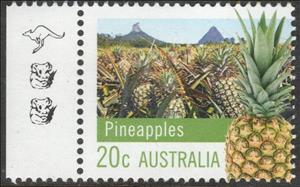Stamp with Collectible Margin: Pineapples 7th reprint - 1 Kangaroo & 2 Koalas (Australia 2025)
Pineapples 7th reprint - 1 Kangaroo & 2 Koalas (Australia 2025)
01 January (Australia ) within release Farming Australia (2nd Series) goes into circulation Stamp with Collectible Margin Pineapples 7th reprint - 1 Kangaroo & 2 Koalas face value 20 Australian cent
| Stamp with Collectible Margin Pineapples 7th reprint - 1 Kangaroo & 2 Koalas in catalogues | |
|---|---|
| Seven Seas Stamps: | Sev: AU 2969f |
| Colnect codes: | Col: AU 2025-01 |
Stamp with Collectible Margin is horizontal format.
The reprint indicators appear in the left and right selvage only - only the right selvage has extended imageStamp with Collectible Margin Pineapples 7th reprint - 1 Kangaroo & 2 Koalas it reflects the thematic directions:
Agriculture is the cultivation and breeding of animals, plants and fungi for food, fiber, biofuel, medicinal plants and other products used to sustain and enhance human life.[1] Agriculture was the key development in the rise of sedentary human civilization, whereby farming of domesticated species created food surpluses that nurtured the development of civilization. The study of agriculture is known as agricultural science. The history of agriculture dates back thousands of years, and its development has been driven and defined by greatly different climates, cultures, and technologies. Industrial agriculture based on large-scale monoculture farming has become the dominant agricultural methodology.
In botany, a berry is a fleshy fruit without a drupe (pit) produced from a single flower containing one ovary. Berries so defined include grapes, currants, and tomatoes, as well as cucumbers, eggplants (aubergines), persimmons and bananas, but exclude certain fruits that meet the culinary definition of berries, such as strawberries and raspberries. The berry is the most common type of fleshy fruit in which the entire outer layer of the ovary wall ripens into a potentially edible "pericarp". Berries may be formed from one or more carpels from the same flower (i.e. from a simple or a compound ovary).: 291 The seeds are usually embedded in the fleshy interior of the ovary, but there are some non-fleshy exceptions, such as Capsicum species, with air rather than pulp around their seeds.
Flora is the plant life occurring in a particular region or time, generally the naturally occurring or indigenous—native plant life. The corresponding term for animal life is fauna. Flora, fauna and other forms of life such as fungi are collectively referred to as biota. Sometimes bacteria and fungi are also referred to as flora, as in the terms gut flora or skin flora.



